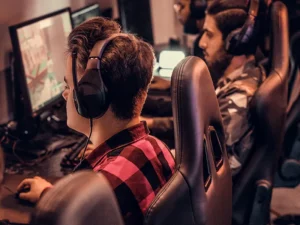The video game industry is booming, with the global market expanding year after year. But game developers have learned that great gameplay and beautiful graphics aren’t enough for international success—it’s also about how well a game can connect with players across different cultures and markets.
Videogame localization is the language solution designed to help with this. It’s an important process that makes sure your game feels like it was made for each target audience, not just translated for them. In this article, we’ll explore what game localization really means, how it helps businesses grow, and what trends are shaping its future.
What is game localization and what are its benefits
If video game translation is about translating words, localization is about translating culture. It adapts video games to the preferences, customs, and even the legal requirements of each target market to make it feel as natural for players as the original version. This might mean translating dialogue, tweaking cultural references, adjusting music or sound effects, and sometimes even changing controls to suit local devices.
Many of us fondly remember the joy of discovering Pokémon when we were kids. All the creatures in the game had delightful and memorable names, and the franchise became a worldwide hit partly because of this smart localization. Instead of just translating the Japanese names directly, they created entirely new names for creatures, attacks, and items to create a stronger emotional connection with players everywhere. This kind of thoughtful localization doesn’t just boost sales; it also wins over critics and helps build a loyal fanbase.
Another important benefit of getting localization right is avoiding misunderstandings or embarrassing mistakes. Many details, like colors, symbols, and narrative devices, that seem perfectly normal in one culture might be confusing or even offensive somewhere else. Adapting these carefully helps game developers steer clear of negative feedback or even bans in certain regions.
The role of localization in business growth
Localization isn’t just about making games more enjoyable—it’s also a powerful business tool. Players today have countless games to choose from, so companies that put effort into proper localization gain a clear advantage over competitors who just do quick translations and call it a day. For developers aiming to expand internationally, localization should be a top priority.
Besides opening new markets, localization helps build player loyalty. When players can relate to the game and see their culture reflected in it, they’re more likely to stick with it and tell their friends about it. In gaming, word-of-mouth recommendations are an incredibly powerful form of organic marketing, as people trust their friends’ opinions about games more than most advertising.
Certain aspects of localization can also help boost revenue by making the actual purchase experience more intuitive. This includes adjusting your pricing to match local economic conditions, using payment methods people actually prefer, and marketing your game in ways that make sense for each region. This flexibility helps games succeed not just in powerhouses like the US and Europe, but also in growing markets where gaming communities are expanding rapidly.
Another key detail is that all localization is (or should be) accompanied by thorough quality checks. This makes sure that all the cultural details were adapted correctly, as well as catching any technical glitches or language mistakes that could spoil the player’s experience. Strong localization quality assurance protects your reputation and helps avoid costly fixes after launch.
Why cultural adaptation Is crucial
Cultural adaptation is probably the trickiest part of localization because you’re dealing with things that go much deeper than language. It involves thinking carefully about how local customs, social norms, and expectations will influence players’ perspectives of the game, and adjusting accordingly. You might need to change character designs, environments, or even gameplay mechanics to match what players in different regions find acceptable and enjoyable.
An issue that comes up frequently in gaming is how to deal with different cultural perspectives on violence and morality, and Call of Duty: Modern Warfare 2 is a prime example of how adaptation works in these situations. The game included a controversial mission called “No Russian” where players participate in a mass shooting in an airport. Different countries handled the graphic violence in this scene in very different ways – Russia removed the entire mission, while Japan and Germany kept it but penalized players for harming civilians. These changes show how the same content can require completely different approaches depending on where you’re releasing.
Even things like music, colors, and imagery carry different meanings in different places. Role-playing games face particular challenges here, as their stories often draw heavily on mythology and local folklore. Adapting these elements can require significant changes to the original, and localization teams must carefully balance those adjustments while preserving the story’s overall coherence.
What’s next for game localization
Advances in technology and new development trends are shaping an exciting future for localization. The arrival of artificial intelligence and machine learning has been a groundbreaking innovation, streamlining game translation services while reducing both costs and time-to-market.
The year 2025 has seen significant progress in generative AI applications for localization. These systems now offer dynamic translation capabilities, automated dubbing solutions, and real-time subtitle generation in multiple languages. This lets developers release games simultaneously worldwide and update them more frequently with increasing precision and customization.
Meanwhile, the growth of cloud gaming platforms and multiplayer environments has also introduced new localization opportunities. Developers are exploring real-time adaptation tools that can adjust game content automatically based on player preferences and cultural contexts, thus providing increasingly personalized gaming experiences.
Another growing focus is inclusive localization. As gaming audiences become more diverse, developers recognize the importance of creating experiences that represent and celebrate different sexual orientations, gender identities, and backgrounds. This inclusive approach not only shows respect for the global gaming community’s diversity but also helps players feel like they belong.
Video game localization has become a key part of game development. Studios that treat it as a strategic investment in global reach, rather than merely a translation expense, position themselves for long-term success. When done well, localization doesn’t just improve the player experience – it drives real business growth.
For developers that want to go global, partnering with professionals who understand both cultural nuance and cutting-edge technology is essential. Explore our specialized gaming localization services and see how Linguaserve can help you optimize your game for audiences worldwide.



